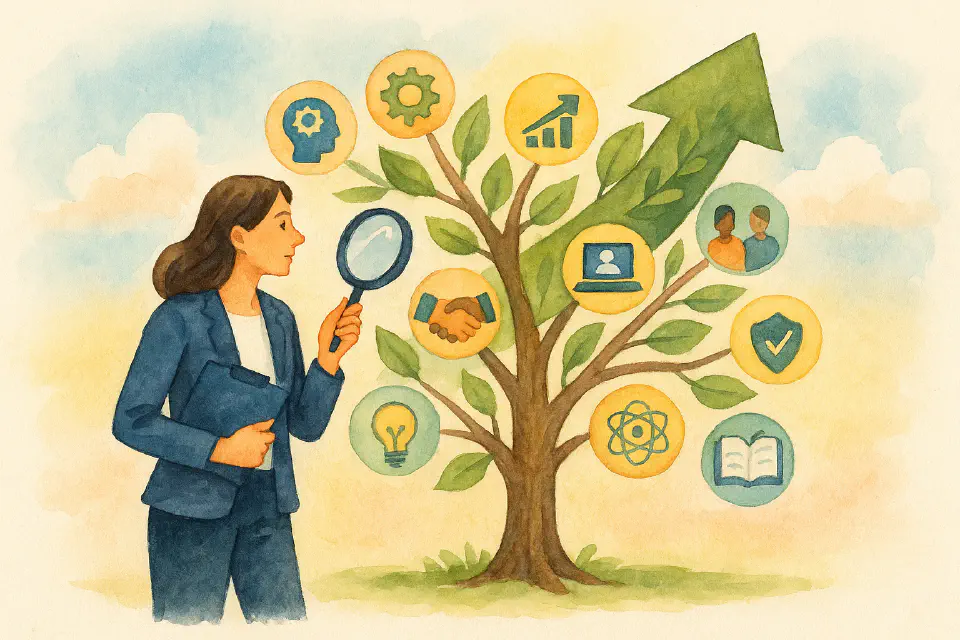
11 HR Trends That Will Shape 2025
HR in 2025 will not just respond to change—it will drive it. As AI reshapes workflows, demographics shift the talent pool, and workplace expectations evolve, HR professionals face a historic opportunity. These 11 HR trends highlight where forward-thinking teams should focus their energy to future-proof both people and performance.
1. From AI Adoption to AI Adaption
The AI hype has finally hit operational reality. Generative AI tools are increasingly part of the everyday HR toolkit, from parsing resumes to drafting job descriptions. But in 2025, the focus shifts from adoption to adaption.
It’s not just about using AI tools—it’s about rethinking how people and machines collaborate. HR teams must:
- Develop internal AI policies
- Upskill recruiters and managers to prompt AI effectively
- Reengineer workflows around smart automation
Companies with strong AI literacy across HR will have a major head start in productivity and decision quality.
2. Skills Mismatch Hits a Breaking Point
By 2025, nearly half of workers’ current skills may be outdated. The rise of automation, green jobs, and remote work has exposed serious gaps in both technical and soft skills. Many organizations lack clear visibility into:
- What skills they currently have
- What skills they’ll need
- How to close the delta
Skills-based organizations (SBOs) are emerging as a solution. These companies design roles, hire talent, and design learning pathways around capabilities, not job titles.
3. Rise of Blue-Collar and “New-Collar” Talent
Skilled trades are back—and so is the prestige that comes with them. While tech layoffs dominated headlines in 2024, manufacturing and infrastructure sectors quietly boomed. Simultaneously, “new-collar” roles in cybersecurity, AI operations, and cloud engineering offer high impact without requiring college degrees.
HR must:
- Rethink work design and flexibility for these roles
- Adapt EVP (Employee Value Proposition) to meet the expectations of hands-on professionals
- Invest in vocational and bootcamp partnerships
4. The Golden Age of Silver Workers
Older workers (65+) are reentering the workforce, and not just part-time. Whether due to financial necessity or purpose-driven motivation, retirees are “unretiring.”
Yet many workplaces aren’t built with them in mind:
- Ergonomics? Often overlooked.
- Health benefits? Not tailored.
- Employer branding? Focused on millennials.
Smart HR teams are:
- Offering phased retirement and mentorship programs
- Customizing wellness and flexibility for older employees
- Tapping into institutional knowledge before it walks out the door
5. The Women’s Equity Effect
Despite more women in leadership than ever before, systemic barriers persist. Flexible work still carries stigma. Menopause is still taboo. And too few DEI programs translate into actual advancement.
In 2025, organizations will need to:
- Normalize health-related accommodations for women
- Prioritize leadership pathways for diverse talent
- Monitor and close pay gaps continuously, not just annually
Equity isn’t a feel-good initiative. It’s a growth driver.
6. Organizational Anxiety & The Big Stay
With recession threats, layoffs, and AI disruption, anxiety in the workplace is at an all-time high. Employees are hunkering down rather than job-hopping—a shift from the Great Resignation to the Big Stay.
Symptoms include:
- Productivity theater (especially in remote roles)
- Managerial micromanagement
- Culture of caution
What HR can do:
- Normalize career conversations, even if internal moves are limited
- Create psychological safety through transparent communication
- Equip leaders to manage in ambiguity
7. HR Execution Becomes a Differentiator
Strategy is sexy, but execution delivers results. In 2025, HR teams that bridge the gap between vision and action will outperform their peers.
This means:
- Tactical HR teams need resources, not just directives
- Execution metrics must be tracked like strategic KPIs
- Collaboration between centers of excellence and business units becomes key
Tactical doesn’t mean junior—it means indispensable.
8. HR Gets Embedded in the Business
The line between HRBP and business partner blurs. Embedded HR means:
- HR advisors are present in daily operations
- They co-create business plans, not just support them
- Data is shared, interpreted, and acted upon collaboratively
This isn’t about making HR more “commercial”—it’s about making business more human-aware.
9. The Antifragile Workforce
Resilience is no longer enough. Antifragility – the ability to grow from stress and disorder – becomes the North Star.
To build it, HR must:
- Redesign work for learning and adaptability
- Integrate wellbeing into performance management
- Build cultures that reward experimentation and recover from failure
Mental health isn’t a benefit—it’s a prerequisite for agility.
10. Real Engagement or Nothing
Engagement rates haven’t moved in 20 years. Why?
- Surveys are too shallow
- Initiatives are too generic
- Managers aren’t trained to act on results
In 2025, we need Engagement 2.0:
- Evidence-based practices (e.g. recognition, fair pay, autonomy)
- Continuous listening, not just pulse checks
- Manager enablement as the central pillar
11. Ethics, Privacy & Algorithmic Accountability
AI doesn’t just create opportunity—it raises questions. Who owns training data? Can we audit AI-based hiring decisions? Are your systems compliant with upcoming EU AI regulations?
HR will be at the center of this shift:
- Vetting AI vendors for bias mitigation
- Updating consent and transparency policies
- Training managers on ethical use of technology
Privacy isn’t optional. Neither is trust.
Final Thoughts: Disruption as a Design Principle
HR in 2025 is more than a function—it’s an architect of resilience, inclusion, and growth. These trends aren’t just predictions. They’re calls to action.
Don’t wait for the future. Build it.